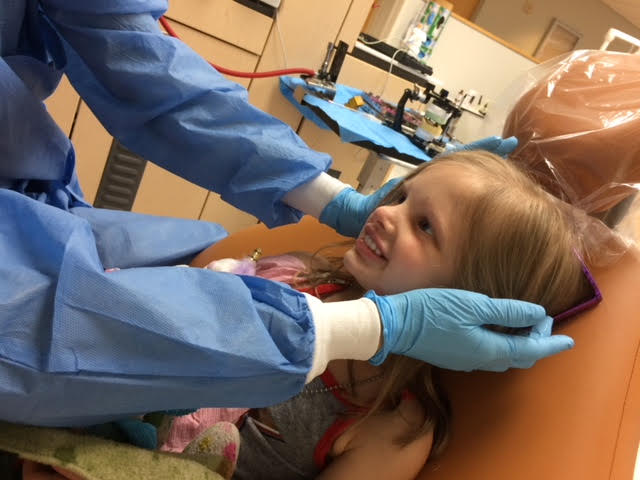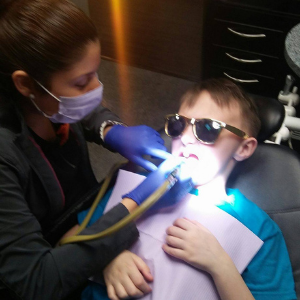By Beau D. Meyer, D.D.S., M.P.H.

Dental care is one of the most common unmet health care needs in children with developmental anomalies or congenital conditions like ectodermal dysplasias.
Many dentists feel uncomfortable treating children, especially children with congenital conditions. Moreover, dental rehabilitation can be very expensive and cost-prohibitive for many families.
As a result, many families may have difficulty finding and subsequently accessing dental care. Thankfully, the National Foundation for Ectodermal Dysplasias has recognized a number of academic health centers and universities as dental treatment centers for patients with ectodermal dysplasias.
These recognized centers offer multi-specialty and interdisciplinary dental treatment for children with congenitally missing teeth. Despite the complexities involved with the dental procedures, these centers offer high quality and technically excellent care.
But what does that actually look like?
A number of thoughts come to mind when I think about what good dental care looks like. It is especially helpful for me, as a clinician, to think about the care I provide in a way that combines the best combination of the patient’s concern, the family’s expectation, the best available evidence, and how treatment timing with respect to child growth will play a role.
Elements of Good Dental Care
Good Dental Care Is Compassionate
Good clinicians take extensive medical, dental, family, and social histories to get to know your child, you, and your family. The discussions that occur before the dentist examines your child give you and your child a chance to be heard. A good dentist reserves judgement and actively listens to your concerns.
A good dentist will take these histories and clinical findings into consideration when thinking about different treatment options. Often, a separate visit will be scheduled for the dentist to present the different treatment options/alternatives and the associated risks and benefits.
You should feel a sense of trust in your provider before ever initiating care. If you feel pressured into making a decision, it is ok for you to call a timeout, express your concerns, and continue the discussion or ask for a second opinion.
There may be times when the dentist is the one feeling pressured into treatment. In such cases, this is frequently a result of expectations that are not aligned. Rather than placing blame, these are opportunities to have additional discussions, seek clarifications, and re-align expectations.
Good Dental Care Is Collaborative
Many people, including clinicians, view collaboration as relationships between multiple providers and their auxillary staff. However, perhaps the two most important collaborators are the child patient and the adult caregivers/parents. You play just as an important of a role in deciding on and complying with the selected treatment option.
Collaboration in a more traditional dental care sense includes consultations with multiple specialists, including pediatric dentist, prosthodontist, and sometimes an oral surgeon. For patients without a diagnosis, a referral to a geneticist and physician for a full work-up is helpful.
Good Dental Care Requires Patience
Resist the temptation to seek a quick fix as a long-term solution, and ask more questions to dentists who propose quick fixes. Children are constantly growing and may outgrow certain dental treatments, especially dentures fabricated at a very young age.
Most dental solutions for missing teeth require multiple steps and visits before the final solution. At the initial visit, the dentist will take photos and x-rays to paint a clear picture of your child’s oral condition.
Sometimes, the dentist will also take impressions or scans of the teeth at the initial visit and/or at subsequent visits depending on how much additional information is needed to generate a full list of treatment options.

Most treatment options include a visit where the appliance is tried-in to verify the fit and esthetics. After that, the final product is delivered, and additional visits for re-adjustments are scheduled as needed.
It is helpful to think about solutions in the short-term (from now until 2-3 years from now), intermediate-term (3-5 years from now until 8-10 years from now), and long-term (beyond 10 years from now). Ask your dentist how a proposed plan will look or change over these time intervals.
Good Dental Care Makes A Difference
More than anything, your child (and you!) should feel good about the care he/she receives. The dental solution should give you and your child more confidence, improved self-esteem, and improved quality of life.
Good Dental Care Should Make You Smile!
Good dental care doesn’t have to be difficult. It is very easy to get lost in the weeds with finding a dentist willing to treat your child, and then thinking about all the steps required to complete treatment. Make sure you get a chance to voice your concerns and expectations, and make sure those align with the treating dentist. You and your child are just as important as the treating dentist in the dental treatment process.
Beau D. Meyer, D.D.S., M.P.H. is a pediatric dentist at The Ohio State University and a member of the NFED Scientific Advisory Council
